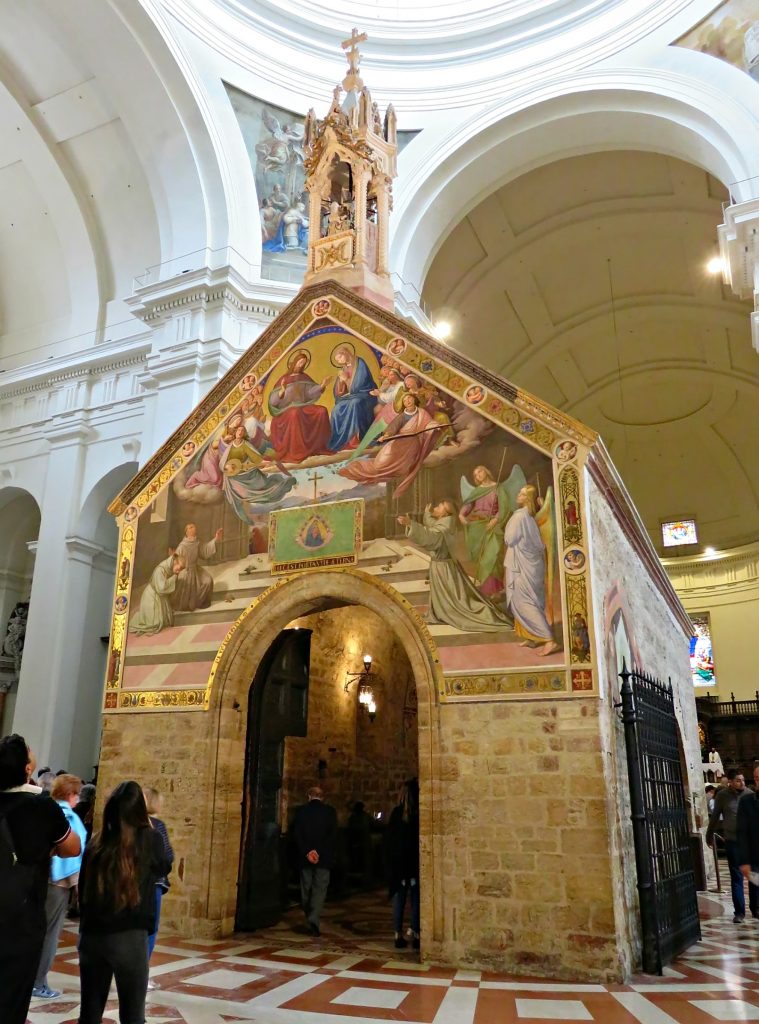Nearly 250 years ago, the first Spanish expedition passing through Alta California, led by Gaspar de Portola, came upon a river that sufficiently inspired Father Juan Crespi, the Franciscan missionary priest in the traveling party, to name it for a little chapel 6,700 miles away.
The day was Aug. 2, 1769, the feast of Our Lady of the Angels of the Porciuncula, also spelled “Portiuncula” and “Porziuncula,” and translated as “a little part.” It is also the name of a tiny church in Italy built (rebuilt, actually) by St. Francis of Assisi — founder of the Franciscans — in his divinely inspired mission to “repair” God’s house.
Thus was the river dubbed “El Rio de los Angeles de la Porciuncula.” Twelve years later, on Sept. 14, 1781, a town by the river was established by a small band of 44 settlers from Mexico: El Pueblo de Nuestra Senora de Los Angeles de la Porciuncula.
The city of Our Lady of the Angels today boasts a cathedral bearing that name, a short walk from where the city’s founding settlers, “Los Pobladores,” first set up camp. Located in the heart of Los Angeles’ Civic Center overlooking the Hollywood Freeway, it is a far cry from St. Francis’ little chapel in the Umbrian countryside.
Nonetheless, the Porciuncula Church of St. Francis of Assisi — at 18 feet by 10 feet, about the size of a nice living room — draws thousands of visitors every year. Many are pilgrims inspired by the example of St. Francis, and all are charmed by the presence of a tiny chapel inside a large basilica.
That would be the Papal Basilica of Santa Maria degli Angeli (St. Mary of the Angels), located two miles from the Papal Basilica of St. Francis of Assisi (where the saint is buried) at the base of the hill town of Assisi, and equidistant from Florence to the northwest and Rome to the south (107 miles each way).
Save for the hill town itself, Santa Maria degli Angeli is easily the most visible building on the Assisi plain and among its most visited, thanks largely to the “church inside a church.”
The Porciuncula chapel, according to legend, was first established in the fourth century, and 500 years later was transformed by Benedictine monks into an actual church.
But like many small churches in Italy, it fell into disrepair until St. Francis, following a pilgrimage to Rome, experienced what he called “a mystical vision of Jesus Christ” in the dilapidated chapel of San Damiano, two miles outside of Assisi.
In his vision, the icon of Christ crucified came alive and three times implored St. Francis to “go and repair my house which, as you can see, is falling into ruins.”
To St. Francis, “repair my house” meant to rebuild the ruined church in which he was praying, a project he financed by selling his horse and fabric from his wealthy father’s shop (annoying his father to no end) and ultimately renouncing all possessions.
He soon restored more poorly maintained churches, among them the Porciuncula chapel, from where St. Francis not only founded the Order of Friars Minor (the Franciscans), he received Clare of Assisi and founded the Second Order of the Poor Ladies (Poor Clares). Until his death in 1226, he regarded the little chapel as a primary source of inspiration.

The Papal Basilica of St. Francis of Assisi, where the saint is buried, rises above the hill town of Assisi. (MIKE NELSON/ANGELUS NEWS)
St. Francis’ followers maintained the Porciuncula Church as a holy site for pilgrims for several hundred years. In the 16th century, St. Pope Pius V, desiring to preserve the little church, launched construction of Santa Maria degli Angeli, a process that began in 1569 (200 years before the Portola expedition in California) and took 110 years to complete.
Over the centuries, the Porciuncula has been embellished by artwork from several periods, including an 1829 fresco by Johann Overbeck depicting St. Francis receiving from Jesus and Mary the indulgence known as the “Pardon of Assisi.”
Inside is a six-part fresco, painted by Father Ilano da Viterbo in 1393, depicting a series of events, including the Annunciation and an apparition of Christ and the Virgin, with St. Francis offering roses.
Today, the Basilica of Santa Maria degli Angeli offers weekday and feast day Masses, confession and eucharistic adoration. The Porciuncula hosts the recitation of the rosary at 5:30 p.m. each weekday.
Collectively, with the basilica on the hill, they are a visible and welcome reminder that, eight centuries after doing God’s work on earth, St. Francis continues to be present to all in the world who follow in his footsteps — even if they are 6,700 miles from home.
Mike Nelson is the former editor of The Tidings (predecessor of Angelus News).
SPECIAL OFFER! 44 issues of Angelus for just $9.95! Get the finest in Catholic journalism with first-rate analysis of the events and trends shaping the Church and the world, plus the practical advice from the world’s best spiritual writers on prayer and Catholic living, along with great features about Catholic life in Los Angeles. Subscribe now!

